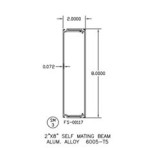Patio Cover Regulations: A Comprehensive Guide
Patio covers, whether freestanding or attached to a dwelling, offer valuable outdoor living space by providing protection from the elements. However, constructing a patio cover is rarely as simple as erecting a structure. Local regulations often govern the design, materials, and placement of these structures, impacting homeowners across diverse jurisdictions. Understanding these regulations is crucial to avoid costly fines, delays, or even the complete removal of a non-compliant patio cover.
The enforcement of patio cover regulations falls primarily under the purview of local building departments. These departments are tasked with ensuring that all construction projects adhere to established building codes and zoning laws. These codes and laws are designed to protect public safety, maintain property values, and ensure that development aligns with the community's overall planning objectives. Failure to comply with these regulations can lead to a range of penalties, including stop-work orders, fines, and legal action. Therefore, a thorough understanding of the applicable rules and regulations before commencing any patio cover construction project is imperative.
Zoning Regulations and Setback Requirements
Zoning regulations are a cornerstone of land-use control and dictate how properties can be used within specific geographic areas. These regulations often include setback requirements, which specify the minimum distance a structure must be from property lines, streets, or other buildings. Setback requirements are designed to maintain open space, prevent overcrowding, and provide adequate access for emergency services. Patio covers are typically subject to these requirements, with the precise setbacks varying depending on the zoning classification of the property and the type of structure being built.
For example, a property zoned as residential may have stricter setback requirements for a patio cover than a property zoned as commercial. Furthermore, the distinction between an attached and a detached patio cover can also influence setback requirements. Detached structures, those independent of the main dwelling, are often subject to more stringent setbacks due to their independence and potential impact on neighboring properties. Homeowners should consult their local zoning ordinances or building department to determine the specific setback requirements applicable to their property. Failing to adhere to these setbacks can result in the denial of a building permit or, worse, the forced relocation of the patio cover after construction.
In some jurisdictions, the size of the patio cover can also impact setback requirements. Larger structures may necessitate greater setbacks to minimize visual impact and ensure adequate space for drainage and landscaping. Additionally, the height of the patio cover can be a factor, particularly in areas with height restrictions. It is vital to assess all relevant zoning regulations encompassing the property to guarantee that the design and placement of the patio cover comply with all legal spatial requirements.
Easements are another significant consideration. An easement grants a third party the right to use a portion of a property for a specific purpose, such as utility lines or drainage. Building a patio cover within an easement can obstruct access to the easement area, potentially leading to legal disputes and the need to relocate the structure. Before commencing any construction, property owners should verify the existence of any easements affecting their property and ensure that the patio cover design does not encroach upon these designated areas.
Building Codes and Permit Requirements
Building codes are a comprehensive set of regulations that establish minimum standards for the design, construction, and maintenance of buildings. These codes are intended to ensure the safety and structural integrity of buildings, protecting occupants and the public from potential hazards. Patio covers, being considered structures, generally fall under the purview of building codes, and compliance is often mandated through a permit process.
A building permit is an official authorization from the local building department to proceed with a construction project. Obtaining a permit typically requires the submission of detailed plans and specifications for the patio cover, including structural drawings, material specifications, and site plans. The building department reviews these documents to ensure that the proposed structure meets all applicable building code requirements. This review process is crucial for identifying potential safety hazards or code violations before construction begins, preventing costly rework and ensuring compliance.
The specific building code requirements for patio covers can vary depending on the type of structure, its size, and its location. Common considerations include structural load requirements, wind resistance, fire safety, and electrical safety. For example, patio covers in areas with high wind loads must be designed to withstand those forces, using appropriate materials and construction techniques. Similarly, patio covers that incorporate electrical wiring, such as for lighting or ceiling fans, must comply with electrical codes to prevent electrical shock and fire hazards.
Some jurisdictions may have specific requirements for the materials used in patio cover construction. For instance, certain types of wood may be prohibited due to fire resistance concerns, or specific types of fasteners may be required to ensure structural integrity. Additionally, the foundation of the patio cover must be adequately designed to support the weight of the structure and prevent settling or movement over time. This might involve constructing concrete footings or using other suitable foundation systems.
Furthermore, the permit process often involves inspections at various stages of construction. Building inspectors will visit the site to verify that the work is being performed in accordance with the approved plans and specifications. These inspections are essential for ensuring that the patio cover is built to code and that any potential problems are identified and corrected promptly. Failure to obtain a building permit or to comply with the requirements of the permit can result in stop-work orders, fines, and the requirement to remove or modify the non-compliant structure.
Homeowners Associations (HOAs) and Deed Restrictions
While zoning regulations and building codes are enforced by governmental entities, homeowners associations (HOAs) and deed restrictions introduce another layer of regulation for many property owners. HOAs are private organizations that manage residential communities, and they often have the authority to enforce rules and regulations governing the appearance and use of properties within the community. Deed restrictions, also known as covenants, are legally binding agreements that are attached to the property deed and restrict the use of the land.
HOAs typically have architectural review committees that review proposals for exterior modifications, including patio covers. These committees are responsible for ensuring that proposed changes comply with the HOA's design guidelines and maintain the aesthetic harmony of the community. The review process may involve submitting detailed plans and specifications, attending meetings, and obtaining written approval before commencing construction. HOAs often focus on aspects such as the appearance of the patio cover, the materials used, the colors, and the overall impact on neighboring properties.
Deed restrictions can also impose limitations on patio cover construction. These restrictions may specify the types of materials that can be used, the size of the structure, or the location where it can be built. Some deed restrictions may even prohibit the construction of patio covers altogether. It is crucial for homeowners to review their HOA documents and deed restrictions carefully before planning a patio cover project. Failure to comply with these regulations can result in fines, legal action, or the requirement to remove the non-compliant structure.
The interplay between HOA regulations, deed restrictions, and local building codes can be complex. In some cases, HOA regulations may be more restrictive than local building codes. In such instances, homeowners must comply with the more stringent requirements. Conversely, if local building codes are more restrictive than HOA regulations, the building codes will take precedence. Navigating this complex regulatory landscape requires careful planning and consultation with both the local building department and the HOA.
Furthermore, it is important to maintain open communication with neighbors throughout the planning and construction process. Informing neighbors about the proposed project and addressing any concerns they may have can help to avoid potential disputes and maintain good relationships within the community. Some HOAs may even require that homeowners obtain written consent from neighboring property owners before approving a patio cover project.
In summary, understanding and adhering to patio cover regulations is essential for a smooth and successful construction project. Property owners must navigate a complex web of zoning regulations, building codes, HOA rules, and deed restrictions to ensure that their patio cover is compliant and meets all applicable requirements. Thorough research, careful planning, and open communication with local authorities and neighbors are key to avoiding costly mistakes and creating a safe and enjoyable outdoor living space.

Do You Need A Patio Cover Permit Renaissance Roofing

Do You Need Footings For Aluminum Patio Covers

Patio Covers City Of San Diego Official Website

Do I Need A Permit For My Alumawood Patio Cover Here S What You To Know Patios

Do You Need Footings For Aluminum Patio Covers
Patio Covers And Carports

Step By Guide To Building A Covered Patio D C Fence

How To Build A Patio Cover

Do You Need A Permit To Build Pergola Outdoor Elements Usa

What Is A Good Size For Covered Patio Ideal Dimensions
Related Posts








